Microsoft 70-411 Practice Exams Free Download From Braindump2go (211-220)
MICROSOFT OFFICIAL: New Updated 70-411 Exam Questions from Braindump2go 70-411 PDF Dumps and 70-411 VCE Dumps! Welcome to Download the Newest Braindump2go 70-411 VCE&PDF Dumps: http://www.braindump2go.com/70-411.html (322 Q&As) Are You Interested in Successfully Completing the Microsoft 70-411 Certification Then Start to Earning Salary? Braindump2go has Leading Edge Developed Microsoft Exam Questions that will Ensure You Pass this 70-411 Certification! Braindump2go Delivers you the Most Accurate, Current and Latest Updated 70-411 Certification Exam Questions Availabe with a 100% Money Back Guarantee Promise! Exam Code: 70-411
Exam Name Administering Windows Server 2012
Certification Provider: Microsoft
Corresponding Certifications: MCSA, MCSA: Windows Server 2012, MCSE, MCSE: Desktop Infrastructure, MCSE: Private Cloud, MCSE: Server Infrastructure Keywords:70-411 Dumps,70-411 Microsoft Exam Questions,70-411 VCE,70-411 PDF,70-411 Practice Exams,70-411 Practice Tests,70-411 Book,70-411 Study Guide 
QUESTION 211
Your network contains an Active Directory domain named contoso. com.
All domain controllers run either Windows Server 2008 or Windows Server 2008 R2.
You deploy a new domain controller named DC1 that runs Windows Server 2012 R2.
You log on to DC1 by using an account that is a member of the Domain Admins group.
You discover that you cannot create Password Settings objects (PSOs) by using Active Directory Administrative Center.
You need to ensure that you can create PSOs from Active Directory Administrative Center.
What should you do? A. Modify the membership of the Group Policy Creator Owners group.
B. Transfer the PDC emulator operations master role to DC1.
C. Upgrade all of the domain controllers that run Window Server 2008.
D. Raise the functional level of the domain. Answer: D
Explanation:
Fine-grained password policies allow you to specify multiple password policies within a single domain so that you can apply different restrictions for password and account lockout policies to different sets of users in a domain. To use a fine-grained password policy, your domain functional level must be at least Windows Server 2008. To enable fine-grained password policies, you first create a Password Settings Object (PSO).
You then configure the same settings that you configure for the password and account lockout policies.
You can create and apply PSOs in the Windows Server 2012 environment by using the Active Directory Administrative Center (ADAC) or Windows PowerShell.
Step 1: Create a PSO
Applies To: Windows Server 2008, Windows Server 2008 R2
http://technet.microsoft.com/en-us//library/cc754461%28v=ws.10%29.aspx 1 QUESTION 212
Your network contains an Active Directory domain named contoso.com. All domain controllers run Windows Server 2012 R2. The domain contains 200 Group Policy objects (GPOs) and 100 WMI filters. An administrator named Admin1 must be able to create new WMI filters and edit all of the existing WMI filters from the Group Policy Management Console (GPMC).
You need to delegate the required permissions to Admin1.
The solution must minimize the number of permissions assigned to Admin1.
What should you do? A. From Group Policy Management, assign Full control to Admin1 for the WMI Filters container.
B. From Active Directory Users and Computers, add Admin1 to the Domain Admins group.
C. From Group Policy Management, assign Creator Owner to Admin1 for the WMI Filters container.
D. From Active Directory Users and Computers, add Admin1 to the WinRMRemoteWMIUsers__group. Answer: C
Explanation:
Users with Full control permissions can create and control all WMI filters in the domain,
including WMI filters created by others.
Users with Creator owner permissions can create WMI filters, but can only control WMI filters that they create.
http://technet.microsoft.com/en-us/library/cc757429(v=ws.10).aspx 2 QUESTION 213
Hotspot Question
Your network contains an Active Directory domain named contoso.com. The domain contains a server named Server1 that runs Windows Server 2012 R2. Server1 has the Windows Server Update Services server role installed. All client computers are configured to download updates from Server1.
You have a Group Policy object (GPO) named GPO1 that is linked to an organizational unit (OU) named Sales_OU.
You need to ensure that all of the computers in Sales_OU are added to a Windows Server Update Services (WSUS) computer group named SalesComputers.
Which setting should you configure in the GPO?
To answer, select the appropriate setting in the answer area. 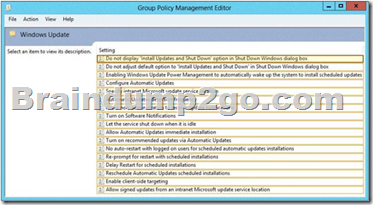
Answer: 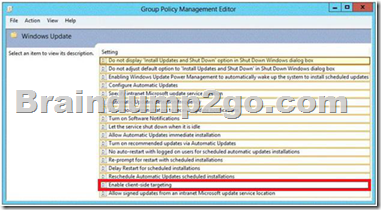
QUESTION 214
Your network contains three Network Policy Server (NPS) servers named NPS1, NPS2, and NPS3. NPS1 is configured as a RADIUS proxy that forwards connection requests to a remote RADIUS server group named Group1.
You need to ensure that NPS2 receives connection requests.
NPS3 must only receive connection requests if NPS2 is unavailable.
How should you configure Group1?
A. Change the Weight of NPS2 to 10.
B. Change the Weight of NPS3 to 10.
C. Change the Priority of NPS2 to 10.
D. Change the Priority of NPS3 to 10. Answer: D
Explanation:
Priority specifies the order of importance of the RADIUS server to the NPS proxy server. Priority level must be assigned a value that is an integer, such as 1, 2, or 3. The lower the number, the higher priority the NPS proxy gives to the RADIUS server. For example, if the RADIUS server is assigned the highest priority of 1, the NPS proxy sends connection requests to the RADIUS server first; if servers with priority 1 are not available, NPS then sends connection requests to RADIUS servers with priority 2, and so on. You can assign the same priority to multiple RADIUS servers, and then use the Weight setting to load balance between them. QUESTION 215
Hotspot Question
Your network contains an Active Directory domain named contoso.com. The domain contains three servers named Server2, Server3, and Server4.
Server2 and Server4 host a Distributed File System (DFS) namespace named Namespace1.
You open the DFS Management console as shown in the exhibit. (Click the Exhibit button.) 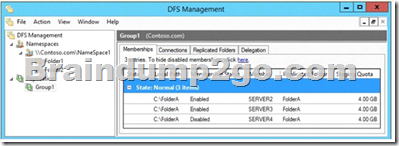
To answer, complete each statement according to the information presented in the exhibit.
Each correct selection is worth one point. 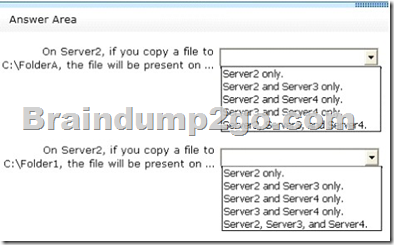
Answer: 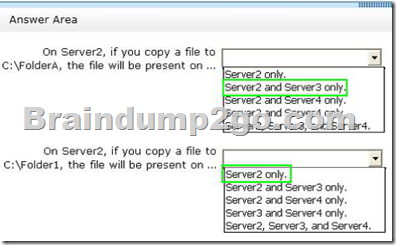
QUESTION 216
Your network contains an Active Directory domain named contoso.com. All domain controllers run Windows Server 2012 R2.
You plan to use fine-grained password policies to customize the password policy settings of contoso.com.
You need to identify to which Active Directory object types you can directly apply the fine-grained password policies.
Which two object types should you identify?
(Each correct answer presents part of the solution. Choose two.)
A. Domain local groups
B. Computers
C. Universal groups
D. Global groups
E. Users Answer: DE
Explanation:
First off, your domain functional level must be at Windows Server 2008. Second, Fine-grained password policies ONLY apply to user objects, and global security groups. Linking them to universal or domain local groups is ineffective. I know what you're thinking, what about OU's? Nope, Fine-grained password policy cannot be applied to an organizational unit (OU) directly.
The third thing to keep in mind is, by default only members of the Domain Admins group can set fine-grained password policies. However, you can delegate this ability to other users if needed.
Fine-grained password policies apply only to user objects (or inetOrgPerson objects if they are used instead of user objects) and global security groups.
You can apply Password Settings objects (PSOs) to users or global security groups:
http://technet.microsoft.com/en-us/library/cc731589%28v=ws.10%29.aspx 4 3 http://technet.microsoft.com/en-us/library/cc731589%28v=ws.10%29.aspx 4 3 http://technet.microsoft.com/en-us/library/cc770848%28v=ws.10%29.aspx 5 http://www.brandonlawson.com/active-directory/creating-fine-grained-password-policies/ 6 QUESTION 217
Your network contains an Active Directory domain named contoso.com. The domain contains a domain controller named DC1 that runs Windows Server 2012 R2. All client computers run Windows 8 Enterprise. DC1 contains a Group Policy object (GPO) named GPO1.
You need to update the PATH variable on all of the client computers.
Which Group Policy preference should you configure? A. Ini Files
B. Services
C. Environment
D. Data Sources Answer: C
Explanation:
Environment Variable preference items allow you to create, update, replace, and delete user and system environment variables or semicolon-delimited segments of the PATH variable. Before you create an Environment Variable preference item, you should review the behavior of each type of action possible with this extension. QUESTION 218
Your network has a router named Router1 that provides access to the Internet.
You have a server named Server1 that runs Windows Server 2012 R2. Server1 to use Router1 as the default gateway. A new router named Router2 is added to the network. Router2 provides access to the Internet. The IP address of the internal interface on Router2 is 10.1.14.254.
You need to configure Server1 to use Router2 to connect to the Internet if Router1 fails.
What should you do on Server1? A. Add a route for 10.1.14.0/24 that uses 10.1.14.254 as the gateway and set the metric to 500.
B. Add 10.1.14.254 as a gateway and set the metric to 500.
C. Add a route for 10.1.14.0/24 that uses 10.1.14.254 as the gateway and set the metric to 1.
D. Add 10.1.14.254 as a gateway and set the metric to 1. Answer: B
Explanation:
To configure the Automatic Metric feature:
1. In Control Panel, double-click Network Connections.
2. Right-click a network interface, and then click Properties.
3. Click Internet Protocol (TCP/IP), and then click Properties.
4. On the General tab, click Advanced.
5. To specify a metric, on the IP Settings tab, click to clear the Automatic metric check box, and then enter the metric that you want in the Interface Metric field.
To manually add routes for IPv4
Open the Command Prompt window by clicking the Start button Picture of the Start button.
In the search box, type Command Prompt, and then, in the list of results, click Command Prompt.
At the command prompt, type route -p add [destination] [mask <netmask>] [gateway]
[metric <metric>] [if <interface>]. QUESTION 219
Your network contains and Active Directory domain named contoso.com. The domain contains a member server named Server1. All servers run Server 2012.
You need to collect the error events from all the servers on Server1. The solution ensure that when new servers are added to the domain, their error events are collected automatically on Server1.
Which two actions should you perform?
(Each correct answer presents part of the solution. Choose two.) A. On Server1, create a source computer initiated subscription.
B. From a Group Policy object (GPO), configure the Configure forwarder resource usage settings.
C. From a Group Policy object (GPO), configure the Configure target Subscription Manager settings
D. On Server1, create a collector initiated subscription. Answer: AC
Explanation:
A. Source-initiated subscriptions allow you to define a subscription on an event collector computer without defining the event source computers, and then multiple remote event source computers can be set up (using a group policy setting) to forward events to the event collector computer.
C. Enable the SubscriptionManager setting, and click the Show button to add a server address to the setting.
http://technet.microsoft.com/en-us/library/cc722010.aspx 7
http://msdn.microsoft.com/en-us/library/windows/desktop/bb870973(v=vs.85).aspx 8 QUESTION 220
Your network contains an Active Directory domain named contoso.com. All domain controllers run Windows Server 2012 R2. DirectAccess is deployed to the network. Remote users connect to the DirectAccess server by using a variety of network speeds. The remote users report that sometimes their connection is very slow.
You need to minimize Group Policy processing across all wireless wide area network (WWAN) connections.
Which Group Policy setting should you configure? A. Configure Group Policy slow link detection.
B. Configure wireless policy processing.
C. Change Group Policy processing to run asynchronously when a slow network connection is detected.
D. Configure Direct Access connections as a fast network connection. Answer: A
Braindump2go Guarantee:
Pass-Certification 70-411 offers absolute risk free investment opportunity, values your timr and money! Braindump2go latest 70-411 Real Exam Dumps - Your success in 70-411 Exam is certain! Your belief in our 70-411 Exam Dumps is further strengthened with 100% Money Back Promise from Braindump2go!
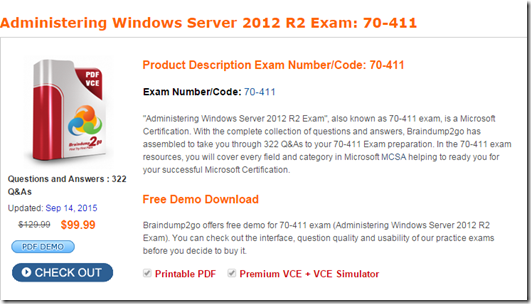
FREE DOWNLOAD: NEW UPDATED 70-411 PDF Dumps & VCE Dumps from Braindump2go: http://www.braindump2go.com/70-411.html (322 Q&As)
|






